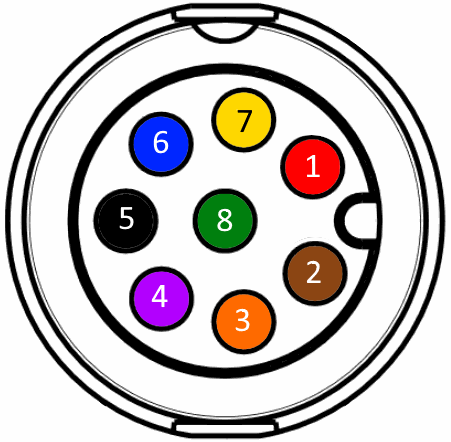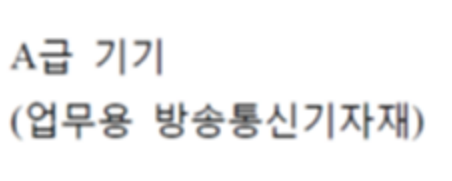Camera Specifications¶
Contents
Temperature¶
The HTP003S should be kept in the following storage, operating, and humidity conditions.
| Storage Temperature | -30 to 60°C |
| Operating Temperature | -20 to 60°C case temperature |
| Humidity | Operating: 20% ~ 80%, relative, non-condensing |
Placing the camera outside of these conditions may result in damage to the device.
The HTP003S is equipped with a built in temperature sensor that can be read by the DeviceTemperature property.
| The camera can get hot to touch if it has been streaming images for an extended period of time. |
| DeviceTemperature can show values outside of the operating temperature range. This is generally acceptable as long as the camera is kept within the stated operating temperature range. |
GPIO Characteristics¶
GPIO Pinout Diagram

GPIO connector as seen from rear HTP003S view. Pin colors correspond to GPIO-M8 cable from Lucid Vision Labs.
| Pin Number | Pin Description |
|---|---|
| 1 (Red) | VAUX (12-24V DC Power Input) |
| 2 (Brown) | Non-isolated bi-directional GPIO channel (Line 2) |
| 3 (Orange) | VDD GPIO (3.5V Power Output) (Line 4) |
| 4 (Purple) | Non-isolated bi-directional GPIO channel (Line 3) |
| 5 (Black) | GND (Camera GND) |
| 6 (Blue) | OPTO GND (Opto-isolated Reference) |
| 7 (Yellow) | OPTO OUT (Opto-isolated Output) (Line 1) |
| 8 (Green) | OPTO IN (Opto-isolated Input) (Line 0) |
Maximum supported input voltage: 24V
Maximum supported output voltage: 24V
Consult the Turning on GPIO Voltage Output section for enabling VDD.
GPIO Schematics¶
Opto-isolated Input – GPIO Line 0¶

Opto-isolated Input Measurements:
| Voltage (V) | Max Rise Delay (us) | Max Fall Delay (us) | Max Rise Time (us) | Max Fall Time (us) | Min Pulse Input (us) | Min Input High (V) | Min Input Low (V) |
|---|---|---|---|---|---|---|---|
| 2.5 | 1 | 1 | 1 | 1 | 2 | 2.5 | 1.0 |
| 5 | 1 | 1 | 1 | 1 | 2 | 2.5 | 1.0 |
Sample values measured at room temperature. Results may vary over temperature and setup.
Opto-isolated Output – GPIO Line 1¶

Opto-isolated Output Measurements:
| Voltage (V) | External Resistor (Ω) | Max Rise Delay (us) | Max Fall Delay (us) | Max Rise Time (us) | Max Fall Time (us) | Current (mA) | Low Level (V) |
|---|---|---|---|---|---|---|---|
| 2.5 | 150 | 50 | 5 | 40 | 5 | 5.7 | 0.9 |
| 2.5 | 330 | 50 | 5 | 40 | 5 | 2.9 | 0.8 |
| 2.5 | 560 | 50 | 5 | 40 | 5 | 1.9 | 0.5 |
| 2.5 | 1k | 50 | 5 | 40 | 5 | 1.2 | 0.3 |
| 5 | 330 | 50 | 5 | 50 | 5 | 6.6 | 0.9 |
| 5 | 560 | 50 | 5 | 50 | 5 | 4 | 0.7 |
| 5 | 1k | 50 | 5 | 50 | 5 | 2.4 | 0.5 |
| 5 | 1.8k | 50 | 5 | 50 | 5 | 1.4 | 0.4 |
| 12 | 1k | 50 | 5 | 60 | 5 | 6 | 0.9 |
| 12 | 1.8k | 50 | 5 | 60 | 5 | 3.4 | 0.9 |
| 12 | 2.7k | 50 | 5 | 60 | 5 | 2.4 | 0.7 |
| 12 | 4.7k | 50 | 5 | 60 | 5 | 1.5 | 0.5 |
| 24 | 1.8k | 60 | 5 | 60 | 5 | 7.1 | 0.9 |
| 24 | 2.7k | 60 | 5 | 60 | 5 | 4.7 | 0.9 |
| 24 | 4.7k | 60 | 5 | 60 | 5 | 2.8 | 0.7 |
| 24 | 6.8k | 60 | 5 | 60 | 5 | 2.1 | 0.6 |
Sample values measured at room temperature. Results may vary over temperature and setup.
Non-isolated Input - GPIO Line 2¶

Non-isolated Input Measurements:
| Voltage (V) | Max Rise Delay (us) | Max Fall Delay (us) | Max Rise Time (us) | Max Fall Time (us) | Min Pulse Input (us) | Min Input High (V) | Min Input Low (V) |
|---|---|---|---|---|---|---|---|
| 2.5 | 1 | 1 | 1 | 1 | 2 | 2.5 | 0.5 |
| 5 | 1 | 1 | 1 | 1 | 2 | 2.5 | 0.5 |
Typical values measured at room temperature. Results may vary over temperature.
Non-isolated Output - GPIO Line 2¶

Non-isolated Output Measurements:
| Voltage (V) | External Resistor (Ω) | Max Rise Delay (us) | Max Fall Delay (us) | Max Rise Time (us) | Max Fall Time (us) | Current (mA) | Low Level (V) |
|---|---|---|---|---|---|---|---|
| 2.5 | 150 | 0.5 | 0.5 | 1 | 0.5 | 4.3 | 1.3 |
| 2.5 | 330 | 0.5 | 0.5 | 1 | 0.5 | 2.6 | 1 |
| 2.5 | 560 | 0.5 | 0.5 | 1 | 0.5 | 1.8 | 0.8 |
| 2.5 | 1k | 0.5 | 0.5 | 1 | 0.5 | 1.1 | 0.6 |
| 5 | 330 | 0.5 | 0.5 | 1 | 0.5 | 5.6 | 1.4 |
| 5 | 560 | 0.5 | 0.5 | 1 | 0.5 | 3.7 | 1.1 |
| 5 | 1k | 0.5 | 0.5 | 1 | 0.5 | 2.3 | 0.9 |
| 5 | 1.8k | 0.5 | 0.5 | 1 | 0.5 | 1.4 | 0.7 |
| 12 | 1k | 0.5 | 0.5 | 1 | 0.5 | 5.5 | 1.4 |
| 12 | 1.8k | 0.5 | 0.5 | 1 | 0.5 | 3.2 | 0.9 |
| 12 | 2.7k | 0.5 | 0.5 | 1 | 0.5 | 2.3 | 0.9 |
| 12 | 4.7k | 0.5 | 0.5 | 1 | 0.5 | 1.5 | 0.7 |
| 24 | 1.8k | 0.5 | 0.5 | 2 | 0.5 | 6.5 | 1.6 |
| 24 | 2.7k | 0.5 | 0.5 | 2 | 0.5 | 4.5 | 1.3 |
| 24 | 4.7k | 0.5 | 0.5 | 2 | 0.5 | 2.6 | 0.9 |
| 24 | 6.8k | 0.5 | 0.5 | 2 | 0.5 | 1.8 | 0.8 |
Typical values measured at room temperature. Results may vary over temperature.
Non-isolated Input - GPIO Line 3¶
Same as Non-isolated Input – GPIO Line 2 (GPIO_IN is Pin 4, GND is Pin 5)
Non-isolated Output - GPIO Line 3¶
Same as Non-isolated Output – GPIO Line 2 (GPIO_OUT is Pin 4, GND is Pin 5)
LED Status¶
The HTP003S camera is equipped with an LED that identifies the current state of the camera.
| LED Status | Status Information |
|---|---|
| Flashing red | Camera powered, but no Ethernet link established. |
| Flashing green | Camera powered, Ethernet link established, but no network traffic. |
| Solid green | Camera powered, Ethernet link established, and there is network traffic. |
| Flashing red/green | Firmware update in progress. |
| Solid red | Error. Firmware update failed. |
The following LED sequence occurs when the camera is powered up and connected to a network:
- LED off, plug in the Ethernet cable.
- LED on, flashing red.
- After link is established, LED becomes flashing green.
- Launch application and start capturing images, LED becomes solid green.
The status LED can also be controlled using the DeviceIndicatorMode property. Possible values are:
- Inactive: LED is off.
- Active: LED indicates camera status according to the above table.
Shock and Vibration¶
Shock and vibration testing for Helios2 cameras to the standards listed on its product page (https://thinklucid.com/product/helios2-time-of-flight-imx556/) is still in progress, and is subject to change.
Specification Tests¶
FCC¶
This product has been tested and complies with the limits for a Class A digital device, pursuant to Part 15 of the FCC Rules. These limits are designed to provide reasonable protection against harmful interference when the equipment is operated in a commercial environment. This equipment generates, uses, and can radiate radio frequency energy and, if not installed and used in accordance with the instruction manual, may cause harmful interference to radio communications. Operation of this equipment in a residential area is likely to cause harmful interference, in which case the user will be required to correct the interference at his own expense.
Users are advised that any changes or modifications not approved by Lucid Vision Labs will void the FCC compliance. The product is intended to be used as a component of a larger system, hence users are advised that cable and other peripherals may affect overall system FCC compliance.
RoHS, REACH, and WEEE¶
Lucid Vision Labs declares the HTP003S camera is in conformity of the following directives:
- RoHS 2015/863/EU
- REACH 1907/2006/EC
- WEEE 2012/19/EC
CE¶
Lucid Vision Labs declares the HTP003S meets requirements necessary for CE marking. The product complies with the requirements of the listed directives below:
- EN 55032:2012 Electromagnetic compatibility of multimedia equipment - Emission requirements
- EN 61000-3-2:2014 Harmonic Current Emissions
- EN 61000-3-3:2013 Voltage Fluctuations and Flicker
- EN 61000-4-2:2008 Electrostatic Discharge
- EN 61000-4-3:2010 Radiated RF Immunity
- EN 61000-4-4:2012 Electrical Fast Transient/Burst
- EN 61000-4-5:2014 Surge Transient
- EN 61000-4-6:2013 Conducted Immunity
- EN 61000-4-8:2009 Power Frequency Magnetic Field
- EN 61000-4-11:2004 Voltage Dips and Interruptions
Korea Communications Commission (KCC) statement¶

Class A Equipment (Industrial Broadcasting & Equipment)

This is electromagnetic wave compatibility equipment for business (Class A). Sellers and users need to pay attention to it. This is for any areas other than home.
